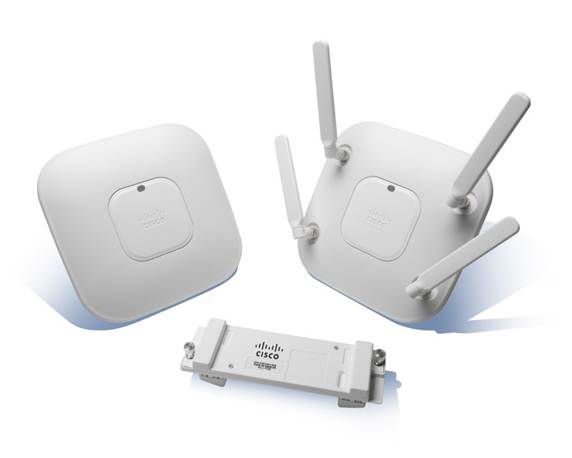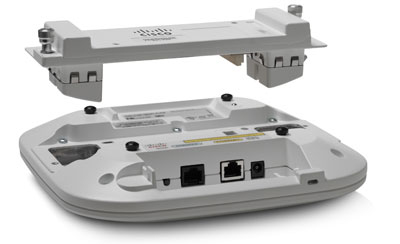
Cisco Aironet 3700 Series Access Point
Industry-Leading Performance and a High Density Experience

מחירים נוספים מופיעים למטה, או לחצו כאן!
שימו לב: כל המחירים באתר כוללים מע"מ. החיוב יבוצע על פי שער "העברות והמחאות מכירה" של המטבע (דולר אמריקאי) ביום אישור ההזמנה.
Overview:
With the industry's only enterprise class 4x4 MIMO, three-spatial-stream access points that support the IEEE's new 802.11ac specification, the Cisco®Aironet® 3700 Series delivers industry-leading performance and a High Density Experience (HD Experience) for both the enterprise and service provider markets. The Aironet 3700 Series extends support to a new generation of Wi-Fi clients, such as smartphones, tablets, and high-performance laptops that have integrating 802.11ac support.
In its first implementation, 802.11ac wave 1 provides a rate of up to 1.3 Gbps, roughly triple the rates offered by today's high-end 802.11n access points. This provides the necessary foundation for enterprise and service provider networks alike to stay ahead of the performance and bandwidth expectations and needs of their wireless users.
Due to its convenience, wireless access is increasingly the preferred form of network connectivity for corporate users. Along with this shift, there is an expectation that wireless should not slow down users' day-to-day work, but should enable a high-performance experience while allowing users to move freely around the corporate environment.
By Utilizing a Purpose-built Innovative Chipset with the Best-in-class RF Architecture for a High Density Experience (HD Experience)
High Density Experience (HD Experience)
Building on the Cisco Aironet heritage of RF excellence, the 3700 Series utilizes a Purpose-built Innovative Chipset with the Best-in-class RF Architecture. This chipset provides a High Density Experience for enterprise network designed for mission critical, high performance applications. The 3700 is a series of flagship access points, delivering industry-leading performance for highly secure and reliable wireless connections and delivers a robust mobility experience that includes:
- 802.11ac with 4x4 multiple-input multiple-output (MIMO) technology with three spatial streams, offering sustained 1.3-Gbps rates over a greater range for more capacity and reliability than competing access points.
- Cross AP Noise Reduction is a Cisco innovation that enables Access Points to intelligently collaborate in real-time to allow more users to connect with optimized signal quality and performance.
- Optimized AP Roaming ensures clients will associate with the best AP offering the best data rate available.
- Cisco ClientLink 3.0 technology to improve downlink performance to all mobile devices, including one-, two-, and three-spatial-stream devices on 802.11ac while improving battery life on mobile devices such as smartphones and tablets.
- Cisco CleanAir technology enhanced with 80MHz Channel Support, provides proactive, high-speed spectrum intelligence across 20-, 40-, and 80-MHz-wide channels to combat performance problems due to wireless interference.
- Modular architecture design that is carried forward from the Cisco Aironet 3600, enabling flexible add-on options in the form of the Cisco Aironet Wireless Security and Spectrum Intelligence Module, the upcoming Cisco 3G Small Cell Module, and the future Cisco Aironet 802.11ac Wave 2 Module, which are tightly integrated with the Aironet 3700 Series Access Point platform and are completely field-upgradable.
- MIMO equalization optimizes uplink performance and reliability by reducing the impact of signal fade.
The new Cisco Aironet 3700 Series sustains reliable connections at higher speeds farther from the access point than competing solutions, resulting in up to three times more availability of 1.3-Gbps rates and optimizing the performance of more mobile devices. The 3700 Series carries forward the modular architecture first introduced with the Aironet 3600 Series and offers unparalleled investment protection, with support for the Cisco Aironet Wireless Security and Spectrum Intelligence Module and the upcoming Cisco 3G Small Cell Module.
All of these features help ensure the best possible end-user experience on the wireless network.
Cisco also offers the industry's broadest selection of 802.11n and 802.11ac antennas, delivering optimal coverage for a variety of deployment scenarios.
Scalability
The Cisco Aironet 3700 Series is a component of the Cisco Unified Wireless Network, which can scale to as many as 18,000 access points with full Layer 3 mobility across central or remote locations on the enterprise campus, in branch offices, and at remote sites. The Cisco Unified Wireless Network is the industry's most flexible, resilient, and scalable architecture, delivering highly secure access to mobility services and applications and offering the lowest total cost of ownership and investment protection by integrating smoothly with the existing wired network.

Features:
Cisco Aironet 3700i Access Point
- Sleek design with internal antennas
- Ideal for office environments
Cisco Aironet 3700e and 3700p Access Points
- Rugged metal housing and extended operating temperature
- Ideal for factories, warehouses, and other indoor industrial environments
- Versatile RF coverage with external antennas
- UL 2043 plenum-rated for above-ceiling installation options or suspended from drop ceilings
- Classify over 20 different types of interference, including non-Wi-Fi interference within 5 to 30 seconds
- Automatic remedial action and less manual intervention
Investment Protection with Flexible Modular Architecture Design
- Cisco Aironet Wireless Security and Spectrum Intelligence Module now shipping
- Cisco 3G Small Cell Module (available 2HCY13)
- Cisco Aironet 802.11ac Wave 2 Module (target CY2015)
Troubleshooting Forensics for Faster Interference Resolution and Proactive Action
- Historic interference information for back-in-time analysis and faster problem solving
- 24x7 monitoring with remote access reduces travel and speeds resolution
- Cisco Spectrum Expert Connect provides real-time, raw spectrum data to help with difficult-to-diagnose interference problems
- Air quality index in Cisco CleanAir® technology provides a snapshot of network performance and the impact of interference
Robust Security and Policy Enforcement
- Industry's first access point with non-Wi-Fi detection for off-channel rogues
- Supports rogue access point detection and detection of denial-of-service attacks
- Management frame protection detects malicious users and alerts network administrators
- Enables policies to prohibit devices that interfere with the Wi-Fi network or jeopardize network security
Secure Interoperability
- Controller-based deployment only
Features and Capabilities
- The industry's first access point with integrated 802.11ac Wave 1 radio to support a 4x4 MIMO with three spatial streams
- Cisco CleanAir Technology with enhanced 80 MHz channel support
- Updated Cisco ClientLink 3.0 to boost performance for all clients, including 802.11ac
- Dual Band 2.4/5 GHz integrated radios to address the growing needs of BYOD and bandwidth demands
- A modular design that supports Cisco Wireless Security and Spectrum Intelligence, Cisco 3G Small Cells, or future 802.11ac Wave 2
Technical Specifications:
| Item | Specification |
|---|---|
| Software | Cisco Unified Wireless Network Software Release 7.6 or later |
| Supported Wireless LAN Controllers |
|
| Module Options | Cisco Aironet Wireless Security and Spectrum Intelligence Module
Cisco 3G Small Cell Module (available 2HCY13)
|
| 802.11n Version 2.0 (and Related) Capabilities |
|
| 802.11ac Wave 1 capabilities |
|
| Integrated Antenna |
|
| External Antenna (Sold Separately) |
|
| Interfaces |
|
| Indicators | Status LED indicates boot loader status, association status, operating status, boot loader warnings, boot loader errors |
| Dimensions (W x L x H) | Access point (without mounting bracket): 8.7 x 8.7 x 2.11 in. (22.1 x 22.1 x 5.4 cm) |
| Weight | 2.5 lbs (1.13 kg) |
| Environmental | Cisco Aironet 3700i
Cisco Aironet 3700e/3700p
|
| System Memory |
|
| Input Power Requirements |
|
| Powering Options | Aironet 3700 without an add-on module
Aironet 3700 with an add-on module
|
| Power Draw | AP3700: 15W Note: When deployed using a Power over Ethernet (PoE) specification, the power drawn from the power sourcing equipment will be higher by some amount dependent on the length of the interconnecting cable. |
| Warranty | Limited Lifetime Hardware Warranty |
| Compliance Standards |
Radio approvals:
IEEE Standard:
Security:
EAP Type(s):
Multimedia:
Other:
|
RF Performance:
| Data rates supported | |||||||
|---|---|---|---|---|---|---|---|
| 802.11a: 6, 9, 12, 18, 24, 36, 48, and 54 Mbps | |||||||
| 802.11g: 1, 2, 5.5, 6, 9, 11, 12, 18, 24, 36, 48, and 54 Mbps | |||||||
| 802.11n data rates on 2.4 GHz: | |||||||
| MCS Index1 | GI2 = 800 ns | GI = 400 ns | |||||
| 20-MHz Rate (Mbps) | 20-MHz Rate (Mbps) | ||||||
| 0 | 6.5 | 7.2 | |||||
| 1 | 13 | 14.4 | |||||
| 2 | 19.5 | 21.7 | |||||
| 3 | 26 | 28.9 | |||||
| 4 | 39 | 43.3 | |||||
| 5 | 52 | 57.8 | |||||
| 6 | 58.5 | 65 | |||||
| 7 | 65 | 72.2 | |||||
| 8 | 13 | 14.4 | |||||
| 9 | 26 | 28.9 | |||||
| 10 | 39 | 43.3 | |||||
| 11 | 52 | 57.8 | |||||
| 12 | 78 | 86.7 | |||||
| 13 | 104 | 115.6 | |||||
| 14 | 117 | 130 | |||||
| 15 | 130 | 144.4 | |||||
| 16 | 19.5 | 21.7 | |||||
| 17 | 39 | 43.3 | |||||
| 18 | 58.5 | 65 | |||||
| 19 | 78 | 86.7 | |||||
| 20 | 117 | 130 | |||||
| 21 | 156 | 173.3 | |||||
| 22 | 175.5 | 195 | |||||
| 23 | 195 | 216.7 | |||||
| 802.11ac data rates (5 GHz): | |||||||
| MCS Index3 | Spatial Streams | GI4 = 800ns | GI = 400ns | ||||
| 20-MHz Rate (Mbps) | 40-MHz Rate (Mbps) | 80-MHz Rate (Mbps) | 20-MHz Rate (Mbps) | 40-MHz Rate (Mbps) | 80-MHz Rate (Mbps) | ||
| 0 | 1 | 6.5 | 13.5 | 29.3 | 7.2 | 15 | 32.5 |
| 1 | 1 | 13 | 24 | 58.5 | 14.4 | 30 | 65 |
| 2 | 1 | 19.5 | 40.5 | 87.8 | 21.7 | 45 | 97.5 |
| 3 | 1 | 26 | 54 | 117 | 28.9 | 60 | 130 |
| 4 | 1 | 39 | 81 | 175.5 | 43.3 | 90 | 195 |
| 5 | 1 | 52 | 108 | 234 | 57.8 | 120 | 260 |
| 6 | 1 | 58.5 | 121.5 | 263.3 | 65 | 135 | 292.5 |
| 7 | 1 | 65 | 135 | 292.5 | 72.2 | 150 | 325 |
| 8 | 1 | 78 | 162 | 351 | 86.7 | 180 | 390 |
| 9 | 1 | - | 180 | 390 | - | 200 | 433.3 |
| 0 | 2 | 13 | 27 | 58.5 | 14.4 | 30 | 65 |
| 1 | 2 | 26 | 54 | 117 | 28.9 | 60 | 130 |
| 2 | 2 | 39 | 81 | 175.5 | 43.3 | 90 | 195 |
| 3 | 2 | 52 | 108 | 234 | 57.8 | 120 | 260 |
| 4 | 2 | 78 | 162 | 351 | 86.7 | 180 | 390 |
| 5 | 2 | 104 | 216 | 468 | 115.6 | 240 | 520 |
| 6 | 2 | 117 | 243 | 526.5 | 130 | 270 | 585 |
| 7 | 2 | 130 | 270 | 585 | 144.4 | 300 | 650 |
| 8 | 2 | 156 | 324 | 702 | 173.3 | 360 | 780 |
| 9 | 2 | 78 | 780 | 780 | - | 400 | 866.7 |
| 0 | 3 | 19.5 | 40.5 | 87.8 | 21.7 | 45 | 97.5 |
| 1 | 3 | 39 | 81 | 175.5 | 43.3 | 90 | 195 |
| 2 | 3 | 58.5 | 121.5 | 263.3 | 65 | 135 | 292.5 |
| 3 | 3 | 78 | 162 | 351 | 86.7 | 180 | 390 |
| 4 | 3 | 117 | 243 | 526.5 | 130 | 270 | 585 |
| 5 | 3 | 156 | 324 | 702 | 173.3 | 360 | 780 |
| 6 | 3 | 175.5 | 364.5 | - | 195 | 405 | - |
| 7 | 3 | 195 | 405 | 877.5 | 216.7 | 450 | 975 |
| 8 | 3 | 234 | 486 | 1053 | 260 | 540 | 1170 |
| 9 | 3 | 260 | 540 | 1170 | 288.9 | 600 | 1300 |
| Frequency band and 20-MHz operating channels | |||||||
A (A regulatory domain):
C (C regulatory domain):
D (D regulatory domain):
E (E regulatory domain):
H (H regulatory domain):
I (I regulatory domain):
K (K regulatory domain):
|
N (N regulatory domain):
Q (Q regulatory domain):
R (R regulatory domain):
S (S regulatory domain):
T (T regulatory domain):
Z (Z regulatory domain):
|
||||||
| Note: Customers are responsible for verifying approval for use in their individual countries. To verify approval and to identify the regulatory domain that corresponds to a particular country, visit http://www.cisco.co.il/go/aironet/compliance. | |||||||
| Maximum number of nonoverlapping channels | |||||||
2.4 GHz
|
5 GHz
|
||||||
| Note: This varies by regulatory domain. Refer to the product documentation for specific details for each regulatory domain. | |||||||
| Receive sensitivity | |||||||
|
|
|
|||||
2.4 GHz
|
5 GHz
|
5 GHz
|
|||||
| 802.11ac Receive Sensitivity | |||||||
802.11ac (non HT80)
|
|||||||
| MCS Index5 | Spatial Streams | VHT20 | VHT40 | VHT80 | VTH20-STBC | VHT40-STBC | VHT80-STBC |
| 0 | 1 | -92 dBm | -89 dBm | -86 dBm | -92 dBm | -89 dBm | -86 dBm |
| 8 | 1 | -70 dBm | -70 dBm | ||||
| 9 | 1 | -66 dBm | -63 dBm | -66 dBm | -63 dBm | ||
| 0 | 2 | -91 dBm | -88 dBm | -85 dBm | |||
| 8 | 2 | -69 dBm | |||||
| 9 | 2 | -65 dBm | -62 dBm | ||||
| 0 | 3 | -90 dBm | -87 dBm | -84 dBm | |||
| 9 | 3 | -67 dBm | -64 dBm | -61 dBm | |||
| Maximum transmit power | |||||||
2.4 GHz
|
5 GHz
|
||||||
| Note: The maximum power setting will vary by channel and according to individual country regulations. Refer to the product documentation for specific details. | |||||||
2.4 GHz
|
5 GHz
|
||||||
| Note: The maximum power setting will vary by channel and according to individual country regulations. Refer to the product documentation for specific details. | |||||||
1MCS Index: The Modulation and Coding Scheme (MCS) index determines the number of spatial streams, the modulation, the coding rate, and data rate values.
2GI: A guard interval (GI) between symbols helps receivers overcome the effects of multipath delays.
3MCS Index: The Modulation and Coding Scheme (MCS) index determines the number of spatial streams, the modulation, the coding rate, and data rate values.
4GI: A guard interval (GI) between symbols helps receivers overcome the effects of multipath delays.
5MCS Index: The Modulation and Coding Scheme (MCS) index determines the number of spatial streams, the modulation, the coding rate, and data rate values.
Documentation:
Download the Cisco Aironet 3700 Series Access Point Datasheet (PDF).
הערות תמחור:
- מחירי המוצרים וזמינותם כפופים לשינויים ללא הודעה מוקדמת.
